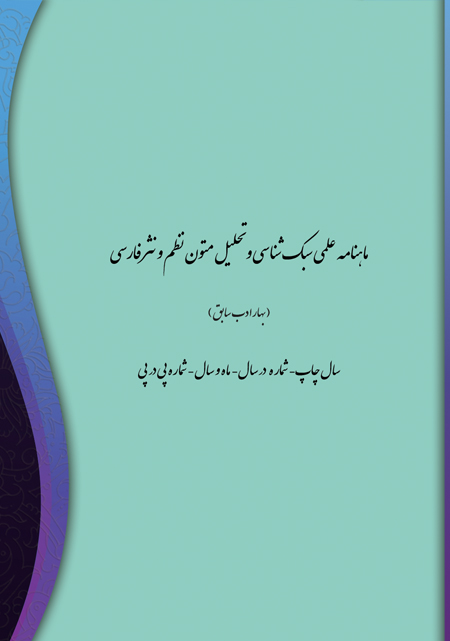- Count View : 8
- آدرس کوتاه شده مقاله: https://bahareadab.com/article_id/1869
- کد doi مقاله: Doi: 10.22034/bahareadab.2025 .18 .7899
Journal of the stylistic of Persian poem and prose
volume Number 18،
number In Volume 6،
،
issue Number 112
Analysis of the most important linguistic features of Sana'i Hadiqat al-Haqiqa
Neda Baradari , Homeira Zomorrodi (Author in Charge), Abdolreza Seif
Abstract
BACKGROUND AND OBJECTIVES: Sana’i Ghaznavi, a pioneering poet and the founder of didactic and mystical masnavi -writing in Persian poetry, occupies a pivotal position in the history of Iran and Persian literature. He played a significant role in the formation of the Iraqi style. On one hand, Sana’i was connected to the classical Khurasani style, while on the other, he introduced linguistic and stylistic innovations inspired by spiritual and mystical foundations. His masterpiece, Hadiqat al-Haqiqah (The Garden of Truth), is considered a turning point in the evolution of moral and mystical masnavis , paving the way for later poets to explore this genre more deeply. Given the historical and literary importance of this work—particularly within the context of Persian mystical poetry—this article aims to investigate the linguistic features of Hadiqat al-Haqiqah and its role in the transition from the Khurasani to the Iraqi poetic style.
METHODOLOGY: This study adopts a descriptive-analytical approach, relying on quantitative data obtained through linguistic induction to examine the linguistic characteristics of Sana’i’s Hadiqat al-Haqiqah . The scope of analysis encompasses syntactic structures, vocabulary, and the poetic style of the work.
FINDINGS: The findings indicate that while certain linguistic features of the early Khurasani style are still present in Hadiqat al-Haqiqah , they have notably diminished in frequency. In contrast, new linguistic elements are emerging, gradually leading to the development of a clear and unified language characteristic of the Iraqi style. Other notable findings include the stabilization of syntactic structures, a reduction in horizontal syntactic disorder, a shift toward abstract over concrete vocabulary, a preference for ascetic rather than epic diction, and an increasing influence of Arabic on the language of the text.
CONCLUSION: While preserving some features of the Khurasani style, Hadiqat al-Haqiqah plays a crucial role in the transformation of Persian poetic language from the classical to the Iraqi style. By balancing tradition and innovation, it laid the groundwork for later works such as Makhzan al-Asrar by Nizami Ganjavi and Bustan by Sa’di Shirazi. Overall, the poem holds a unique place as a symbol of linguistic and stylistic evolution in Persian poetry.
Keyword
Sana’i Ghaznavi
, Hadiqat al- Haqiqah
, Khurasani style
, Iraqi style
, Language.
- Akbari, Manouchehr; Moshayekhi, Sara. (2020). “A Study of Text Cohesion Factors in the Evidence of Sanai’s Hadiqat al-Haqiqah.” Journal of Persian Language and Literature, No. 88, pp. 63–87.
- Behnamfar, Mohammad. (2009). “Analysis of Structure and Style in Sanai’s Letters.” Humanities Quarterly of Al-Zahra University (Mystical Literature), No. 1, pp. 1–31.
- Forouzanfar, Badi al-Zaman. (1990). Speech and Orators. Tehran: Kharazmi Publications.
- Hasan-Nejad Sheikh-Mohammad, Azadeh. (2019). Stylistics and Genre Analysis of the Mystical Hadiqah. Tehran: Bu Ali Educational and Research Publications.
- Kasayi, Norollah. (1995). Nizamiyya Schools and Their Scientific and Social Impacts. 3rd ed. Tehran: Amir Kabir Publications.
- Mahyar, Mohammad. (2005). “Some Linguistic Features of Rawd al-Jinan.” Bayyinat, No. 47, pp. 78–83.
- Modarres-Razavi, Mohammad-Taqi. (1965). Commentary on the Hadiqah. 1st ed. Tehran: Scientific Publishing Institute.
- Maroof, Atiqullah. (1962). “Ghurids and Ghaznavids.” Ariana, No. 236, pp. 49–56.
- Meshkin Dayem-Hoshi, Shahriar. (2012). “A Study of Sanai’s Mystical Thoughts in Hadiqat al-Haqiqah, Its Sources, and the Preparation of a Subject Index.” PhD Dissertation. Tarbiat Moallem University of Tehran.
- Pishgar, Ahad; Zarei, Zahra. (2011). "A Stylistic Examination of Poets’ Responses to One of Sanā’ī’s Ghazals". Journal of Persian Poetic and Prose Stylistics (Bahar-e Adab) , No. 14, pp. 235–252.
- Qavam, Abolqasem; Hashemi, Zohreh. (2013). “Functions of Epic and Mythological Elements of Shahnameh in the Divan and Hadiqat al-Haqiqah of Sanai.” Mystical and Mythological Literature, No. 31, pp. 127–157.
- Sana'i, Majdud ibn Adam. (2005). Hadiqat al-Haqiqah wa Shari‘at al-Tariqah, ed. Mohammad-Taqi Modarres Razavi. 6th ed. Tehran: University of Tehran Press.
- Shafiee Kadkani, Mohammad-Reza. (No date). General Stylistics. Tehran: Mitra Publications.
- Shamisa, Sirous. (1993). Stylistics of Prose. Tehran: Mitra Publications.
- Tabatabaei, Seyyed Mahdi. (2021). “Suggestions for Transcribing Certain Words and Phrases in Hadiqat al-Haqiqah.” Poetry Studies, No. 48, pp. 121–148.
- Toqiyani Esfarjani, Eshaq. (1997). “Stylistic Features of Sanai’s Hadiqah.” Applied Sociology, No. 8, pp. 23–38.
- Zomorrodi, Homeira. (2017). The Theory of Paradox in the Structure of Mystical Language. 3rd ed. Tehran: Zowar Publications.
- Zarrinkoub, Abdolhossein. (2005). Step by Step Until Meeting God. Tehran: Elmi Publications.

